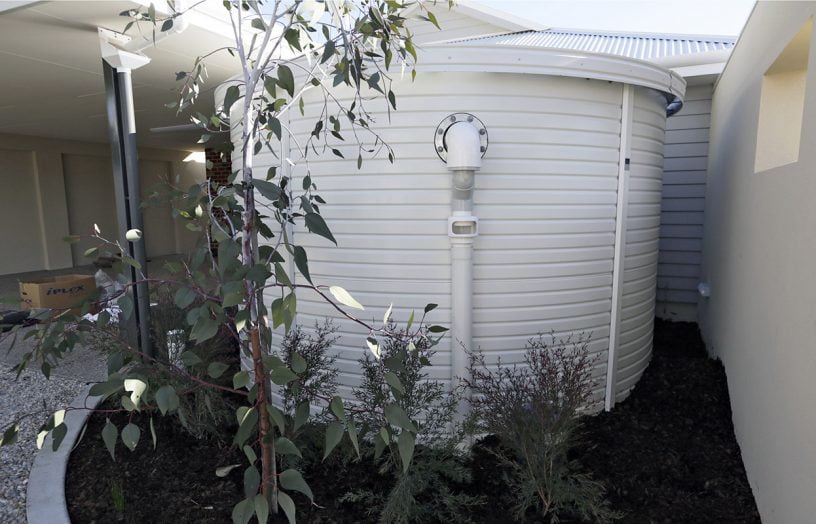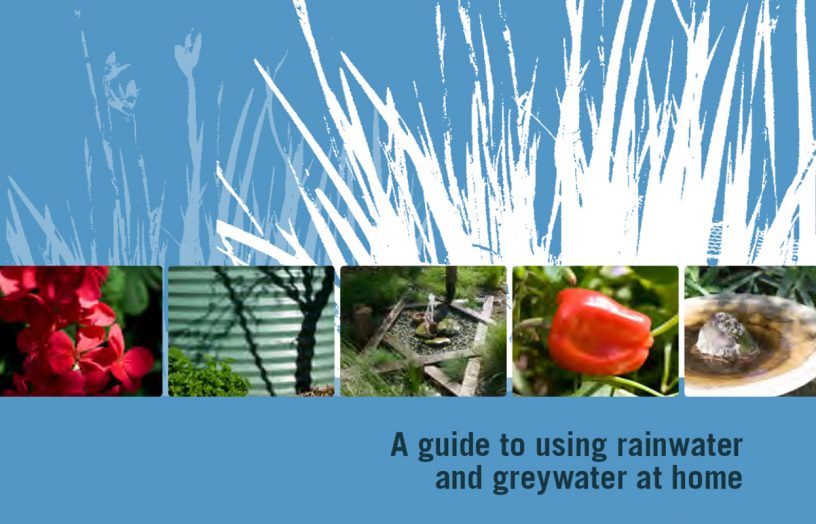Get more out of your water
Although many regions no longer have water restrictions, water is still a very precious resource in a country as dry as Australia. Greywater systems let you use water at least twice, which makes good environmental sense.
The advantage of greywater is that we produce it on a daily basis. In many cases it can be diverted to the garden with minimal effort and cost in a number of different ways. You can opt for a low-cost DIY system using something as simple as a greywater diversion hose attached to your washing machine outlet. Or you might be considering installing a full commercial greywater system. Whichever way you go, our resources and expert advice can help you plan the best system for your home and garden. Get started with Renew magazine’s Greywater System Buyers Guide here.
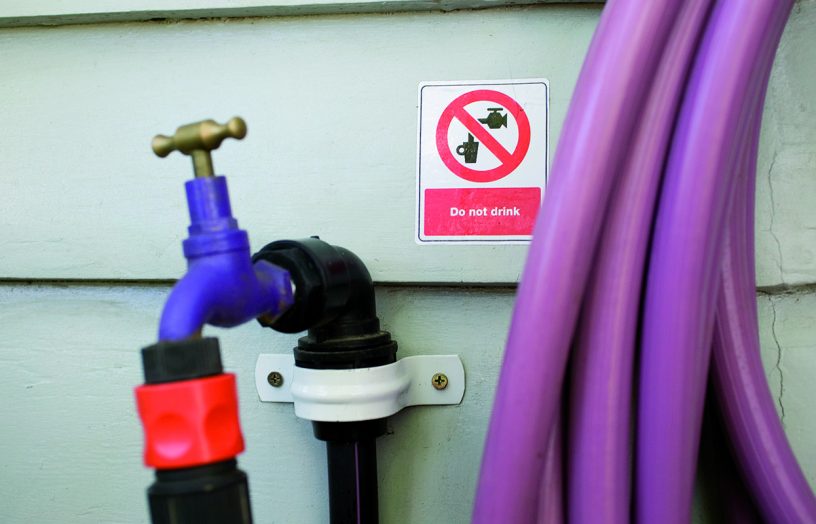
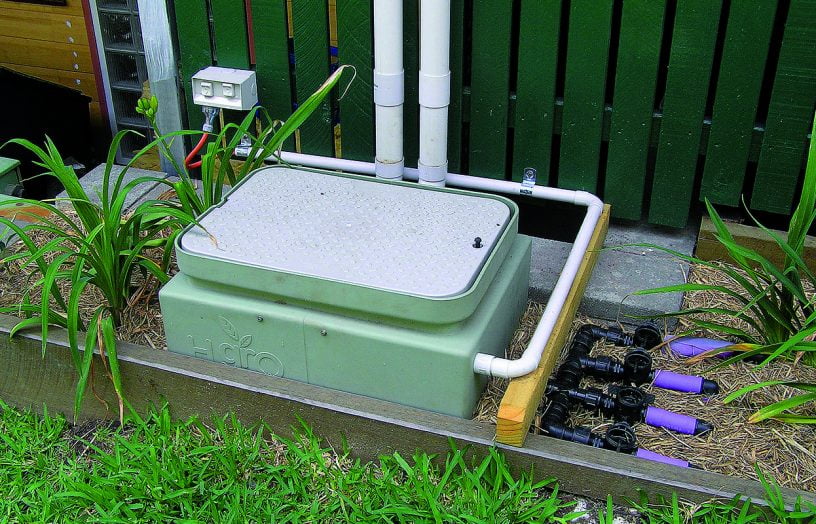
According to Renew magazine’s Greywater System Buyers Guide, greywater is any wastewater generated from your laundry (sinks and appliances), bathroom (baths, showers, basins) and kitchen (sinks and dishwashers), before it has come into contact with the sewer. It does not include toilet wastewater, which is classed as blackwater.
Treated greywater can be used in the garden, both above and below the surface, to flush the toilet and to wash a load of clothes in the washing machine. Untreated grey water can only be used for sub-surface irrigation in the garden, to prevent any contact with the greywater.
Greywater is not the same as water straight out of the tap. It also contains whatever you have mixed with it or contaminated it with. Because of this, greywater can be harmful to people, plants and soil.
Understanding what is in greywater will help you avoid any unwanted outcomes from using or treating greywater. It’s a matter of avoiding or minimising harmful detergents or cleaners, and being careful how you use or treat greywater.
It’s worth considering the health and environmental issues in relation to each source of greywater from your house – the laundry, bath, shower, basin and kitchen – to work out the appropriate use of the greywater. The health and environmental issues are relevant if you are using greywater without treating it, and also relevant to onsite treatment of greywater.
The following list from Water Not Down the Drain explains what’s in greywater around the home.
Laundry water
Laundry water can contain soaps, detergents, water softeners, bleaches, lint, dirt and small amounts of skin or faecal matter from the clothes or nappies. Laundry water contains the most phosphorus and sodium salts in household water.
Shower and bath water
Water from the shower or bath can contain soaps, shampoo, hair, skin, oil, faecal matter and urine. It can also contain chemicals used for cleaning the shower and bath, such as disinfectants, mould removers and other cleansers.
Basin water
Water from the basin can contain soap, toothpaste, mouthwash, shaving cream and hair.
Kitchen water
Kitchen sink or dishwasher water can contain soap, detergents, food scraps, grease and oils.
It is important to understand what is required to install a greywater system on your property. Greywater regulations and permit requirements vary across Australia and you will need to check what the regulations are for your particular area. Permit requirements can even vary from one local council to another within your state or territory, so it is important to contact your local council first. Table 1 in the print version of the Greywater Systems Buyers Guide (available here) summarises state and territory regulations and highlights the main relevant documents, but you should also consult your council to check in case of specific regulations for your local council area, or regulation changes.
Australian Standards apply to plumbing pipes and fixtures used for greywater. Purple is the colour used to identify products suitable for use with greywater or recycled water. Where the pipes that are supplying greywater or recycled water are buried they must have identification tape installed running along the top of the pipe. Taps for recycled water must also be identified with signage saying Do Not Drink.
Greywater cannot be connected to pipes also supplying mains water or rainwater. It needs to be distributed by a separate network of pipes. The exception is garden irrigation where the supply is only connected at the time of irrigation, meaning that rainwater and greywater are not connected at the same time.
Greywater and rainwater can’t be stored in the same tanks. Rainwater tanks need to be plumbed to overflow to the stormwater network. Greywater tanks need to be plumbed to overflow to the sewer.
Find out more in Water Not Down the Drain.
Firstly decide what you want to use greywater for. If it is simply to water the garden, a greywater diversion system will probably suit your needs. If you want to use greywater for toilet flushing, laundry, or watering the vegetable garden then you will need a system that treats greywater so that it is a suitable quality.
The cost of treatment systems is usually substantially more than the cost of diversion systems. While diversion systems start in price from below $100, treatment systems are typically thousands of dollars.
Bear in mind that each system type has different regulations governing its use depending on which state or territory you live in.
Find out more in the Greywater System Buyers Guide.
Treatment systems improve the quality of greywater to allow a greater range of uses such as above-ground in the garden, in the laundry and toilet, and can allow long term storage of the treated water. They can be a year round solution to using greywater, rather than a dry weather only solution.
There are a variety of ways of treating greywater, including biological, chemical and a combination of both. Treated greywater can be used in a wide range of applications, including laundry washing (in some states), and can also be stored—something that should not be done with untreated greywater.
Most treatment systems are expensive, usually in excess of $5000, and often require ongoing energy, maintenance and periodic water quality testing costs. Treatment systems may be ideal for some applications, especially where large volumes of greywater are produced daily and the gardens are big enough to utilise the water. However, it may be simpler and cheaper to use a rainwater tank for laundry water supply, combined with a simple diversion-and-filter system for laundry and bathroom greywater reuse.
Read Renew magazine’s Greywater System Buyers Guide for more on treatment systems.
A simple greywater diversion system will suit most people for watering the garden. Many of these systems are low-cost, reasonably easy to use, and can get a regular supply of water to your garden right when it needs it.
Greywater diversion systems divert greywater to the garden without treating it. They can include simple mesh filters to capture hair or lint, but they don’t treat the water to remove biological or chemical contamination. This means that the greywater cannot be stored because the contamination will increase, exposing you to greater risk. Also, you can’t put the greywater onto edible plants in case it contacts the part of the plant to be eaten.
Systems that divert water to the garden are typically designed for seasonal use in dry weather. If the garden doesn’t need the water, the default is to send that water down the drain to the sewer or treatment system.
In many respects, capturing and diverting greywater is the easy part of greywater reuse; distributing it through your garden can be more complicated and requires careful planning in order to deliver the right amount of water to each area. There are many irrigation alternatives that all have their pros and cons. Some of the commercially available greywater systems offer the installation of the irrigation system as part of the package.
Agi-pipe
One of the simplest ways to deliver greywater below the surface is through perforated pipe (agi-pipe), laid in filled trenches, 100 to 200 mm below the surface. Agi-pipe is flexible polyethylene pipe that has holes in it to allow water to seep out. Common diameters range from 50 mm to 100 mm, so it can easily be laid beneath the surface, even in narrow garden beds. Its flexibility also means it can bend around fairly sharp corners.
Drip irrigation
Some systems use dripper lines to deliver greywater. The advantage of dripper lines is that they are extremely efficient as they deliver water where it’s needed, at the root zone, and at slow rates that minimise wastage. This means that larger areas can be irrigated with smaller volumes of water. They are equally suitable for lawns and large areas of individual plants.
Mulch basins
Mulch basins are perhaps the only system of greywater irrigation that can deal with no filtration, potentially even from kitchen water (assuming sodium levels are kept to a minimum). It uses large diameter piping that can handle large organic particles and delivers the water directly to the mulch basin.
A mulch basin is simply a scooped out donut-like hole around the trunk of a tree, generally lined at the sides with rocks to stabilise the soil and covered with mulch to avoid people coming into contact with the greywater. The greywater outlet pipe is situated below the mulch but above the soil. The mulch acts as a sponge that soaks up the greywater and then slowly releases it.
The Greywater System Buyers Guide explains these irrigation systems in more detail.
In some states, constructed wetlands or reed beds are an approved method to deal with greywater. These use sand, gravel and plants to filter and biologically cleanse the water as it flows through the wetland. The bottom of the wetland area is lined with an impermeable layer to stop the water seeping into the ground. They are deliberately designed to reduce the amount of water through evaporation and transpiration by the plants. In that sense, constructed wetlands offer a treatment and landscaping option rather than the best water recycling option if you want to maximise the water available for other plants.
Having said that, water passing through a constructed wetland could then be directed to other parts in the garden for irrigation where needed. Constructed wetlands offer a low energy and low maintenance option for treating greywater. Potentially, water from a constructed wetland could be disinfected for indoor use similar to other treatment systems.
Greywater can keep your garden alive and may help it flourish. Greywater can replace the use of drinking water on the garden, thus allowing that water to remain in rivers or to be used for other purposes.
But there can be some negative environmental impacts that stem from the amount or type of contamination in the water. Negative impacts can be avoided by considering the most likely causes.
Stuart McQuire in his book Water Not Down the Drain explains the environmental impact of water from all areas of the home, from kitchen water to water contaminated with household cleaning products.
Follow these tips and check Water Not Down the Drain for more advice.
- Only apply greywater to the garden when it needs the water, and make sure there is no surface run-off or water logging
- Rotate greywater to different parts of your garden rather than always to the same spot
- Use the minimum amount recommended (or less) of detergents, cleaners and shampoos
- Choose liquid laundry detergents that are low in sodium. They will have a lower pH than powders
- Choose low phosphate laundry detergents and cleaning products
- Avoid detergents that contain boron and don’t use borax
- Avoid shampoos that contain selenium
- Avoid the use of bleaches or disinfectants that may harm the plants or soil
- Keep an eye on your plants for burnt, discoloured or stunted leaves
- Add organic matter and gypsum to improve soil structure
- Keep soil mulched to improve and maintain its structure
- Monitor the pH of the soil periodically
- Water with rainwater or mains water periodically to give the garden a break from grey water.
It’s best that some contaminated water just doesn’t make it into your greywater system, or your garden. Here’s Stuart McQuire’s list from Water Not Down the Drain.
- Bleach
- Disinfectant
- Chlorine
- Drain cleaner
- Ammonia
- Window cleaner
- Laundry powders high in salt or pH
- Nappy cleaners or water from nappy washing
- Hair dyes
- Nail polish removers and nail polish
- Mouthwash
- Bath bombs
- Cooking oils
- Kitchen water or dishwasher water
- Insect or spider killers and repellents
- Garden chemicals including fertilisers, herbicides and pesti-cides
- Automotive chemicals including motor oil, brake fluid, coolant and cleaners
- Shed chemicals including paint, turpentine, kerosene or methylated spirits
- Home office chemicals including ink or toner.
LATEST ARTICLES
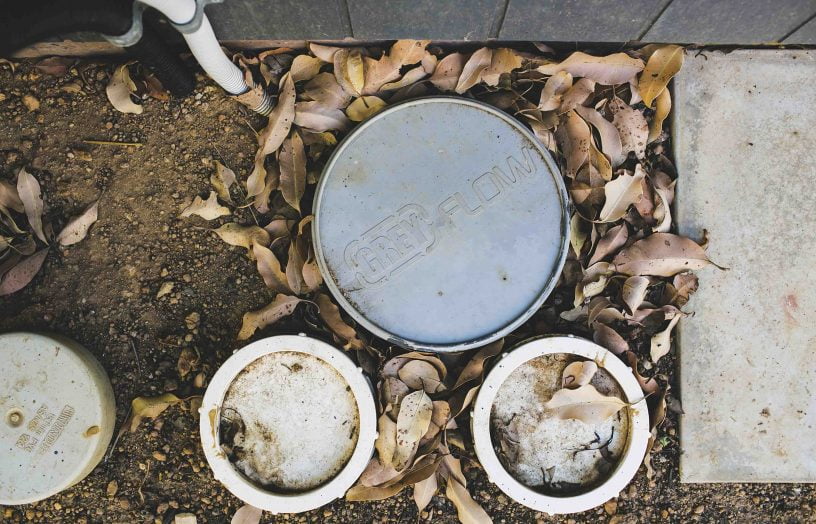 Outdoors
Outdoors
A better shade of grey: Grey water in your garden
Potable water is becoming the world’s liquid gold, and in the driest continent on earth, it’s priceless. Horticulturist Michael Tanner outlines how you can help save this precious resource by going grey in the garden.
Read more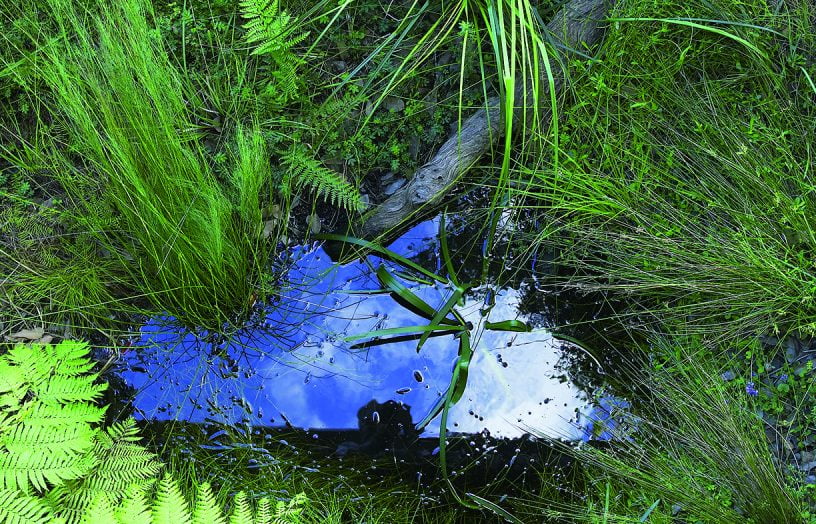 Outdoors
Outdoors
Gardening with stormwater
Don’t let all the water go down the drain: use clever landscape design to keep your garden thriving with stormwater.
Read more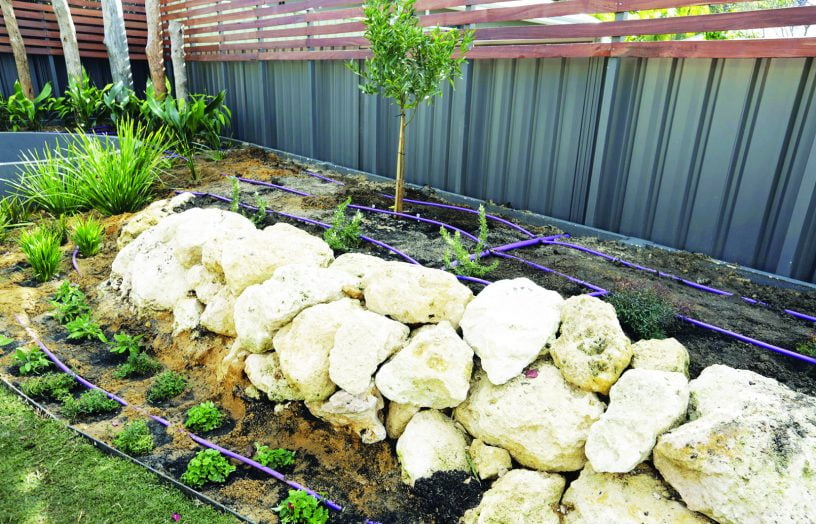 Buyers guides
Buyers guides
Greywater system buyers guide
Although many regions no longer have water restrictions, water is still a very precious resource in a country as dry as Australia. Greywater systems let you use water at least twice, which makes good environmental sense. Here, we look at what systems are available.
Read more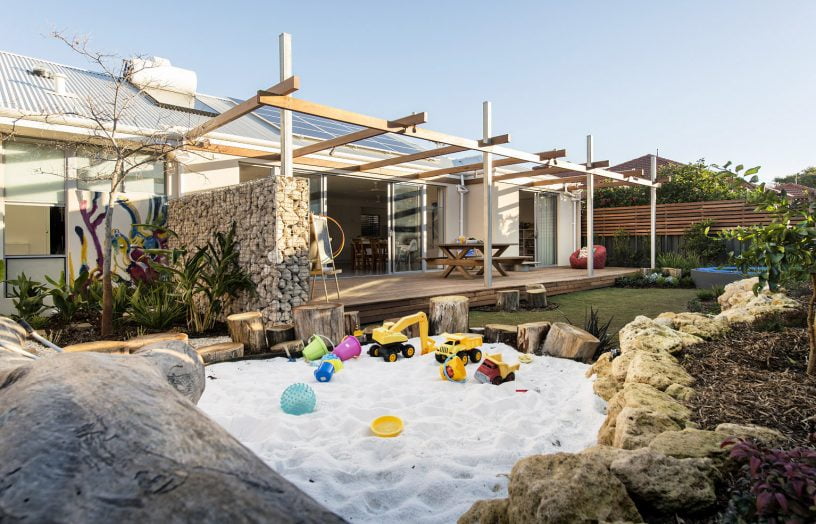 Water saving
Water saving
Josh’s house and garden
Behind 10 Star Josh’s House is a productive, water smart and shade-giving garden—and you can find the plans online, writes Jacinta Cleary.
Read more


